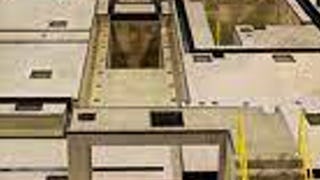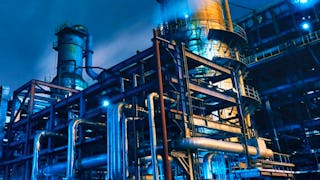Welcome to the Heavy Manufacturing course, where we explore the intricate techniques and technologies essential for modern manufacturing. This comprehensive program delves into three key areas: Machining Processes in Manufacturing, Fluid Power System in Production and Controls of Manufacturing, and Pressure Vessel Specialized Manufacturing, Surface Treatment, and Refractory Materials. Through theoretical knowledge and hands-on practical applications, students will gain a deep understanding of the principles, methodologies, and best practices shaping the field of advanced manufacturing.

Genießen Sie unbegrenztes Wachstum mit einem Jahr Coursera Plus für 199 $ (regulär 399 $). Jetzt sparen.

Heavy Manufacturing Process and System
Dieser Kurs ist Teil von Spezialisierung für Heavy Manufacturing

Dozent: Subject Matter Expert
1.548 bereits angemeldet
Bei enthalten
Empfohlene Erfahrung
Kompetenzen, die Sie erwerben
- Kategorie: Mechanical Engineering
- Kategorie: Failure Analysis
- Kategorie: Manufacturing Processes
- Kategorie: Robotics
- Kategorie: Equipment Design
- Kategorie: Manufacturing Operations
- Kategorie: Maintenance, Repair, and Facility Services
- Kategorie: Thermal Management
- Kategorie: Automation
- Kategorie: Hydraulics
- Kategorie: Materials science
- Kategorie: Quality Assurance
- Kategorie: Control Systems
Wichtige Details

Zu Ihrem LinkedIn-Profil hinzufügen
3 Aufgaben
Erfahren Sie, wie Mitarbeiter führender Unternehmen gefragte Kompetenzen erwerben.

Erweitern Sie Ihre Fachkenntnisse
- Lernen Sie neue Konzepte von Branchenexperten
- Gewinnen Sie ein Grundverständnis bestimmter Themen oder Tools
- Erwerben Sie berufsrelevante Kompetenzen durch praktische Projekte
- Erwerben Sie ein Berufszertifikat zur Vorlage

In diesem Kurs gibt es 3 Module
Machining operations are essential to modern manufacturing, including a diverse range of techniques for shaping and finishing raw materials into precise components. Machining procedures are fundamentally about removing material from a workpiece to produce the desired form, size, and surface quality. Understanding the systems, equipment, and activities involved is critical for improving manufacturing efficiency and quality. The contact between a cutting tool and the workpiece is crucial to the material removal mechanism, which is generally accomplished by metal cutting. Cutting forces, chip formation, and surface finish are all heavily dependent on tool geometry, material composition, and cutting angles. As cutting advances, tools wear and finally fail, reducing machining accuracy and efficiency. Monitoring tool wear and failure scenarios are critical for ensuring proper machining performance and tool life. Various types of chips can occur during machining, depending on factors such as cutting speed, feed rate, and tool shape. Understanding chip formation mechanisms is essential for optimizing machining parameters and avoiding chip-related problems such as built-up edges and poor surface finish. Furthermore, heat generation during machining can affect tool life and workpiece integrity, emphasizing the significance of cooling solutions such as cutting fluids. Common machining operations include turning, shaping, drilling, milling, and grinding, each with their own characteristics and applications. Specialized methods like as deep hole drilling, jig grinding, and complex shape machining allow for the precise manufacturing of sophisticated components for a wide range of industries. Thread machining processes, such as thread whirling, provide effective options for creating threaded products with high precision and surface quality. CNC machines in modern production automate tool movements and enable complicated geometries, revolutionizing machining operations. Understanding CNC machines and programming principles is critical for increasing production efficiency and flexibility while adhering to stringent quality standards. In conclusion, machining operations are fundamental to production, providing adaptable options for creating a wide range of components with precision and efficiency. By mastering machining principles and processes, Manufacturer may attain peak performance and competitiveness in today's dynamic industrial world.
Das ist alles enthalten
18 Videos1 Aufgabe
Fluid power systems play a pivotal role in modern manufacturing, providing efficient and reliable means of transmitting power through the use of pressurized fluids, typically hydraulic oil or compressed air. These systems offer numerous advantages, including high power density, precise control, and versatility in a wide range of applications. Pumps, actuators, valves, and fluid reservoirs are essential components of fluid power systems. Hydraulic systems use hydraulic pumps to generate high-pressure fluid, which is transmitted through control valves to actuators like hydraulic cylinders or motors. In contrast, pneumatic systems use compressors to generate compressed air, which is then controlled by pneumatic valves and transferred to pneumatic actuators such as cylinders or rotary actuators. Control valves regulate fluid flow and pressure inside the system. There are several types of control valves available, including directional, pressure, and flow control valves. Pressure control valves, such as relief valves and pressure reducing valves, regulate the system's pressure levels within acceptable limits, providing safe and effective operation. Servo valves control fluid flow precisely and are widely employed in high-performance applications that require quick response and accuracy. Hydraulic-powered circuits are widely used in manufacturing operations such as milling, grinding, shaping, drilling, hydraulic presses, and forklift machines. These circuits provide exact control over motion and force, resulting in effective material removal, shaping, and lifting activities. Application circuits in pneumatic systems are designed to perform specialized functions including two-handed safety, clamp pressure control, and dual pressure control. These circuits use pneumatic actuators and control valves to achieve the desired motion and force in manufacturing processes. Despite their dependability, fluid power systems can develop problems like as leakage, component wear, or contamination, resulting in reduced performance or system failure. Routine maintenance and troubleshooting are critical for identifying and resolving problems quickly, ensuring smooth operation and minimizing downtime in manufacturing operations. The troubleshooting stages for pneumatic systems and servo valves include a systematic identification of symptoms, component inspection, and corrective actions to restore optimal performance. Regular maintenance methods, such as fluid inspection, filter replacement, and component lubrication, help extend the lifespan and reliability of fluid power systems, assuring continuous production processes.
Das ist alles enthalten
12 Videos1 Aufgabe
Pressure vessels are critical components in many industries, as they are designed to properly contain fluids or gases at high pressures and temperatures. Specialised manufacturing procedures and surface treatments are required to assure reliability and endurance under rigorous working conditions. Shear cutting, water jet cutting, plasma arc cutting, and laser cutting are some of the cutting processes used in pressure vessel fabrication. These technologies provide precision and adaptability in forming vessel components from basic materials like steel plates. Shrink fitting is a process for assembling cylindrical components that involves heating one part to expand it, allowing for the insertion of another part, which shrinks when cooled, resulting in a tight interference fit. Tube-to-tubesheet welding, which includes techniques such as Inert Gas Backing Welding (IBW) and orbital welding, provides leak-free connections between tubes and tubesheets in heat exchangers and other vessel components. Tube-to-tubesheet joint expansion increases the mechanical strength and sealing integrity of these connections. Robotic welding systems are used for high-volume, complex welding activities that require precision and consistency in joined vessel components. Electro Discharge Machining (EDM) is a method for machining precise shapes in hard materials such as refractory metals, providing precision and variety in pressure vessel manufacture. Specialized machining procedures are used to create the desired forms and dimensions in pressure vessels composed of Fibre Reinforced Polymer (FRP) or ceramics. Surface preparation processes, such as cleaning, blasting, and chemical treatments, are critical for assuring coating adhesion and improving corrosion resistance in pressure vessel components. Painting and thermal spray aluminum (TSA) coating are two popular surface treatment procedures used to protect pressure vessel surfaces from corrosion and increase their service life in extreme conditions. In pressure vessels working at high temperatures, refractory materials are used to provide thermal insulation and protect the vessel walls from heat damage. Overall, specialized manufacturing techniques and surface treatments are essential to the design and maintenance of pressure vessels, assuring their dependability and safety in a variety of industrial applications.
Das ist alles enthalten
16 Videos1 Aufgabe
Erwerben Sie ein Karrierezertifikat.
Fügen Sie dieses Zeugnis Ihrem LinkedIn-Profil, Lebenslauf oder CV hinzu. Teilen Sie sie in Social Media und in Ihrer Leistungsbeurteilung.
Dozent

von
Mehr von Mechanical Engineering entdecken
Warum entscheiden sich Menschen für Coursera für ihre Karriere?




Häufig gestellte Fragen
To access the course materials, assignments and to earn a Certificate, you will need to purchase the Certificate experience when you enroll in a course. You can try a Free Trial instead, or apply for Financial Aid. The course may offer 'Full Course, No Certificate' instead. This option lets you see all course materials, submit required assessments, and get a final grade. This also means that you will not be able to purchase a Certificate experience.
When you enroll in the course, you get access to all of the courses in the Specialization, and you earn a certificate when you complete the work. Your electronic Certificate will be added to your Accomplishments page - from there, you can print your Certificate or add it to your LinkedIn profile.
Yes. In select learning programs, you can apply for financial aid or a scholarship if you can’t afford the enrollment fee. If fin aid or scholarship is available for your learning program selection, you’ll find a link to apply on the description page.
Weitere Fragen
Finanzielle Unterstützung verfügbar,








